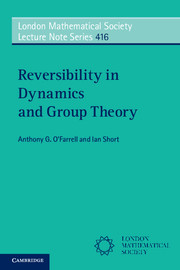Book contents
- Frontmatter
- Contents
- Preface
- 1 Origins
- 2 Basic ideas
- 3 Finite groups
- 4 The classical groups
- 5 Compact groups
- 6 Isometry groups
- 7 Groups of integer matrices
- 8 Real homeomorphisms
- 9 Circle homeomorphisms
- 10 Formal power series
- 11 Real diffeomorphisms
- 12 Biholomorphic germs
- References
- List of frequently used symbols
- Index of names
- Subject index
Preface
Published online by Cambridge University Press: 05 June 2015
- Frontmatter
- Contents
- Preface
- 1 Origins
- 2 Basic ideas
- 3 Finite groups
- 4 The classical groups
- 5 Compact groups
- 6 Isometry groups
- 7 Groups of integer matrices
- 8 Real homeomorphisms
- 9 Circle homeomorphisms
- 10 Formal power series
- 11 Real diffeomorphisms
- 12 Biholomorphic germs
- References
- List of frequently used symbols
- Index of names
- Subject index
Summary
Reversibility is the study of those elements of a group that are conjugate to their own inverses. Reversible maps appear naturally in classical dynamics; for instance, in the pendulum, the n-body problem, and billiards. They also arise in less obvious ways in connection with problems in geometry, complex analysis, approximation, and functional equations. When a problem has a connection to a reversible map, this opens it to attack using dynamical ideas, such as ergodic theory and the theory of flows. Reversibility has its origins in work of Birkhoff, Arnol'd, Voronin, Sevryuk, Siegel, Moser, Smale, and Devaney, among others, mainly in the context of continuous dynamical systems [8, 9, 10, 11, 31, 32, 66, 131, 211, 214, 237]. Devaney initiated the formal study of smooth reversible systems, not necessarily derived from a Hamiltonian, and there has been considerable work on such systems. The main focus has been on higher dimensions, and the systematic study of discrete reversible systems in low dimensions is more recent. We concentrate here on the discrete system theory, and on developments since the turn of the century.
The subject relates to involutions, conjugacy problems, and automorphism groups. The reversible elements of a group are those elements that are conjugate to their own inverses, and the strongly-reversible elements are those elements that are conjugate to their own inverses by involutions. Both types of element have been studied in many contexts. For finite groups, the terms real and strongly real are used instead of reversible and strongly reversible [117, Section 9.1] because of the connections with real characters. Questions of reversibility for classical groups have been addressed in works such as [82, 150, 151, 153]. The authors of these papers use the term bireflectional to describe a group comprised entirely of strongly-reversible maps. There is a rich modern literature on reversibility in dynamical systems, which includes [16, 66, 159, 160, 162, 163, 164, 165, 198, 199, 205, 211].
- Type
- Chapter
- Information
- Reversibility in Dynamics and Group Theory , pp. ix - xiiPublisher: Cambridge University PressPrint publication year: 2015

